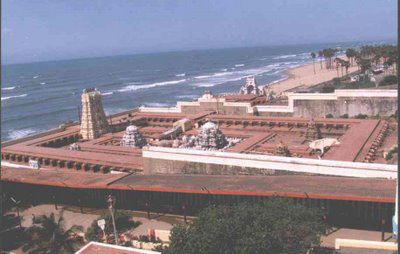Tamil Nadu - Temples - Thiruchendur Murugan Temple
Thiruchendur Murugan Temple
Thiruchendur Murugan Temple is one of the Lord Murugan temple and one of the Arupadaiveedu (six major abodes) of Lord Muruga. It is located in the small town of Thiruchendur in the district of Tuticorin.
Mythology
Thiruchendur is the place where Lord Muruga used as the base camp, before invading the demon king of Suran in Sri Lanka.Near the temple is also a holy place for the Ayyavazhi sect, where Ayya Vaikundar is said to have performed his Avatar according to Akilattirattu Ammanai, the holy book of Ayyavazhi.
Temple Beauty
The Avast mandapam with 124 pillars adorns the entrance to the main temple.The sanctum of Lord Shanmukha with his consorts is visible from this Mandapam itself. It is named Shanmukha Vilasam. The principal entrance of the templefaces the south and opens into the first temple prakaram. It is the SiviliMandapam. Towards the west of the southern portal of the first prakaram,the shrine of Dakshinamoorty, facing south, is situated. Further west at the corner there is a mandapam where the processional deities are decorated during festivals. It is at this mandapam that the annual Tirukalyanam of Valli on Panguni Uthiram day is held. Further north on the western portalis the idol of Lord Subramanya astride a peacock giving battle to Surapadman.Sivalingams follow at intervals. The main western gopuram stands on the outer side of this doorway. Welcoming the devotees here is a giant idol of Lord Ganesha, better known as Mukkuruni Pillaiyar. On the northern portal is the shrine of Venkatesh, hollowed out of rock. Sri Venkatesa is seen in a standingposture. Adjacent to it in a carved grotto are Gajalakshmi, Pallikonda Ranganathar, Sridevi, Bhudevi and Neeladevi. The twelve Alwars are also depicted here.

ValliCave
There is a separate cave situated about 200 feet north of the main temple. A picturesque grotto is carved out of hardened sandstone. Two images are installed there, one dedicated to Valliand the other to Dattatreya. Behind the frontal cave, there is a circular passage with another grotto carved from inside, with an idol of Valli in a niche. The cave temple has recently been given a face-lift.
Shanmukha's Shrine
In a separate shrine, facing south, there is Shanmukha with his consorts Valli and Deivayanai. These beautiful copper idols are decorated with dazzling diamonds and gold ornaments. The Lord is holding various weapons on his twelve hands. Colourfully painted on the walls here are Puranic scenes. All the 33 verses of Sri Adi Sankara's Bhujangam are written on the walls. To the right of Shanmukha's shrine, there is another shrine in which the processional bronze deities of Nataraja, the Samayachariars, Thirugnana Sambandar, Appar, Sundarar and Manickavachagar and of Saint Cheraman Perumal,the Chera King, are installed.
Surasamharam
Legend has it that at this holy place Lord Subramanya annihilated Surapadman, who along with his brothers Singamukha and Taraka, was reigning Triloka(the Heaven, the Earth and the Pathala). At the pinnacle of his fame, the demon subjected the Devas to untold miseries. The distressed Devas ills. These were carried to the Himalayan lake Saravana through the Holy Ganges by Agni, the God of Fire. There they took the formsof six divine babies on lotus flowers. They were nourished by the Krithikanymphs. The six babies, on being embraced by Parvathi, Siva's consort,took one divine from with six heads and twelve hands and came to be known as Shanmukha and Arumukha, the six-faced. In this form, the Lord reached Tiruchendur from Kailas on his mission of subduing the Asuras. Here, he desired a shrine of Siva for his worship. Mayan, the celestial, was orderedto build the temple on the shores. The Lord plunged into the divine missionand fought the demon and his hordes for six days, on land, under the seaand in the air. The war saw the end of all except Surapadman, who rosein the form of a mango tree in the middle of the ocean. The Lord took Indraas his charger, challenged the demon in his island fortress and piercedthe Asura King into two. The body thus left out took the forms of a cock and a Peacock, but still would not give in. They too were fought to the finish, and the demon, who was penitent before death, was forgiven by Muruga.In his infinite mercy the Lord gave Viswaroopa darshan and adopted the peacock as his permanent charger, relieving Indra, and the cock as hisbanner. The Asura thus came to stay in the above two forms ever in the presence of the Lord. To commemorate this victory, a festival called SkandaSashti is celebrated at Tiruchendur as well as in other shrines of LordMuruga for six days with all pomp and piety. On the concluding day, theepic battle Surasdmhara ( the annihilation of Surapadman ) is re-enactedin all its true form, witnessed by devotees in thier thousands. After thesuccessful mission, the Lord, it is said, turned again at Tiruchendur,halted and worshipped Siva at the temple built by Mayan.invokedLord Siva for deliverance. Lord Siva extended his merciful eye of protectionand sent six fire.

